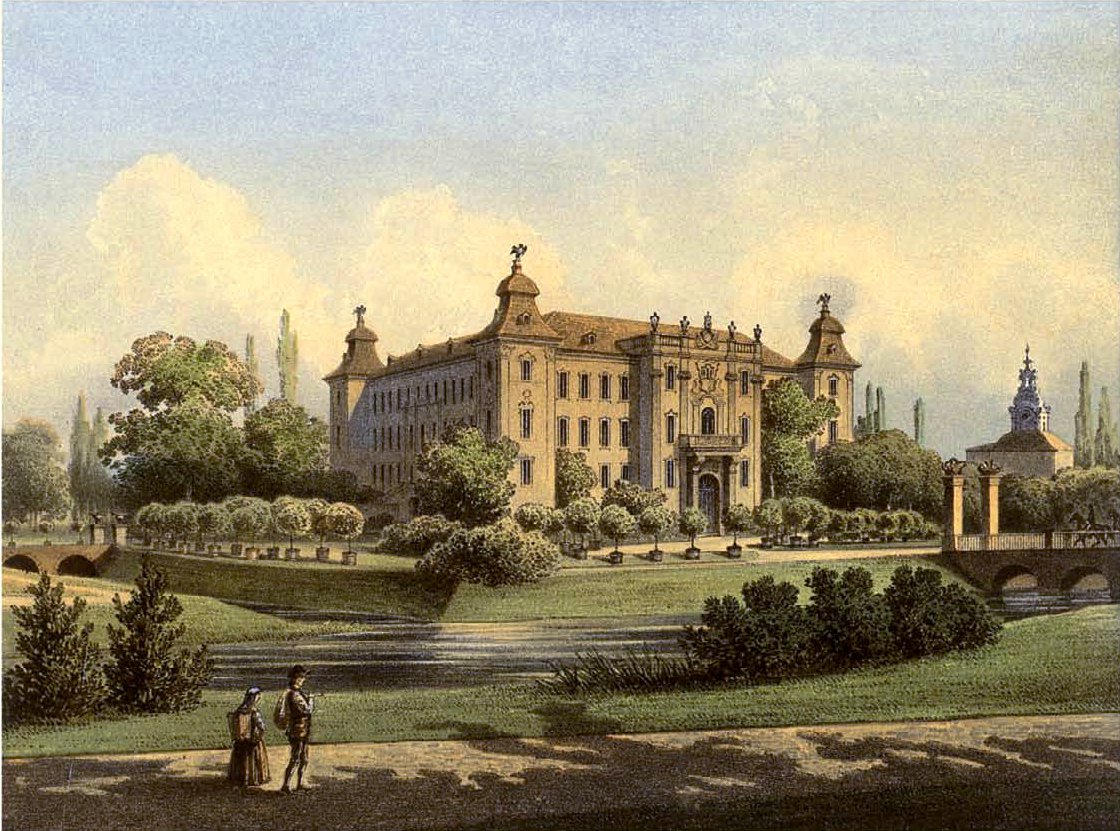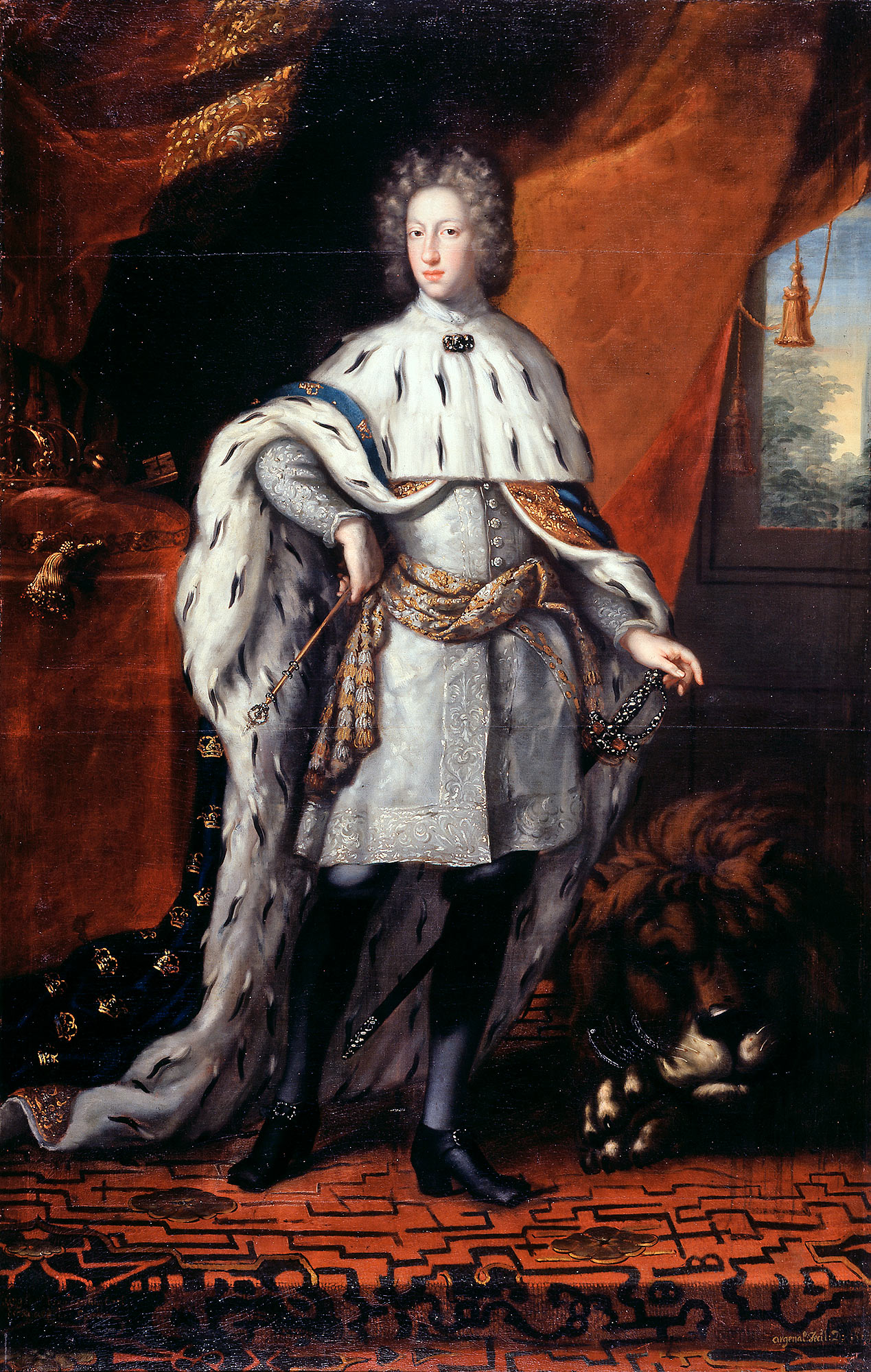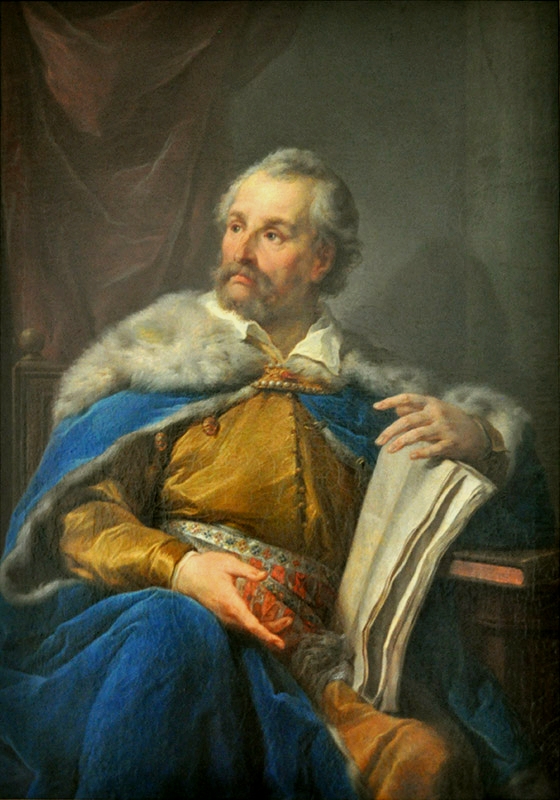|
Catherine Opalińska
Countess Catherine Opalińska ( pl, Katarzyna Opalińska; 13 October 1680 – 19 March 1747), was by birth member of House of Opaliński, Queen consort of the Polish–Lithuanian Commonwealth twice and Duchess consort of Lorraine through her marriage with Stanisław I of Poland. Biography Catherine was the daughter of the magnate Count Jan Karol Opaliński and Zofia Czarnkowska. On May 10, 1698 in Kraków she married Stanisław Leszczyński, who became Duke of Lorraine and was, briefly, king of Poland (reigned as Stanisław I). In 1699, she gave birth to Anna Leszczyńska, and in 1703, to Marie Leszczyńska, the future spouse of Louis XV of France. Catherine suffered 20 miscarriages between 1700 and 1720. Queen In 1704, her spouse was elected King of Poland after having been supported as a candidate by Charles XII of Sweden, who had at the time placed Poland under his occupation. Between November 1704 and July 1705, Charles XII had his headquarters at Rawicz, and the royal cou ... [...More Info...] [...Related Items...] OR: [Wikipedia] [Google] [Baidu] |
Queen Consort Of Poland
The wives of the rulers of the Kingdom of Poland were duchesses or queens consort of Poland. Two women ruled Poland as queens regnant, but their husbands were kings ''jure uxoris''. Wives of early Polish monarchs Duchesses of the Polans Queens and High Duchesses of Poland Piast Dynasty (1) Přemyslid Dynasty Piast Dynasty (2) Angevin Dynasty Jagiellon Dynasty Royal consort of the Polish–Lithuanian Commonwealth * Elżbieta Szydłowska (1748–1810) was the lover of King Stanisław August. Some believe that she married the King of Poland in 1783, but their marriage was morganatic, so she wasn't Queen of Poland. However, there is no known reason for the marriage to have been morganatic, as Poniatowski's Pacta conventa required him to marry a Polish noblewoman, a requirement she satisfied, and there is no evidence that the marriage ever occurred. According to Wirydianna Fiszerowa, a contemporary who knew them both, the rumour only arose after th ... [...More Info...] [...Related Items...] OR: [Wikipedia] [Google] [Baidu] |
Roman Catholic
Roman or Romans most often refers to: *Rome, the capital city of Italy *Ancient Rome, Roman civilization from 8th century BC to 5th century AD *Roman people, the people of ancient Rome *''Epistle to the Romans'', shortened to ''Romans'', a letter in the New Testament of the Christian Bible Roman or Romans may also refer to: Arts and entertainment Music *Romans (band), a Japanese pop group * ''Roman'' (album), by Sound Horizon, 2006 * ''Roman'' (EP), by Teen Top, 2011 *"Roman (My Dear Boy)", a 2004 single by Morning Musume Film and television *Film Roman, an American animation studio * ''Roman'' (film), a 2006 American suspense-horror film * ''Romans'' (2013 film), an Indian Malayalam comedy film * ''Romans'' (2017 film), a British drama film * ''The Romans'' (''Doctor Who''), a serial in British TV series People * Roman (given name), a given name, including a list of people and fictional characters * Roman (surname), including a list of people named Roman or Romans *Ῥωμα� ... [...More Info...] [...Related Items...] OR: [Wikipedia] [Google] [Baidu] |
Rydzyna Castle
The Rydzyna Castle is a Baroque castle in Rydzyna, Poland. It was built in the beginning of the 15th century by Jan of Czernina. At the end of the 17th century, Italian architects Joseph Simon Bellotti and Pompeo Ferrari erected the present Baroque castle on its ancient foundations. The first owners of the castle were the Leszczyński family. Together with a park and surrounding areas, it was one of the most splendid palaces in Great Poland. Italian Heritage The residence was built by Giuseppe Simon Belotti from Lugano, at the end of the 17th century. Not only was he an architect but also a manager of stucco workshops and a supervisor of decorative works made by Italian plasterers and sculptors. Belotti designed the Leszczyńskis’ Palace in ‘palazzo in modo fortezza’ style, following the example of Poggio Reale by Sebastiano Serlio (Serliano). Another Italian artist who settled in Poland, Michelangelo Palloni from Florence, decorated ceilings in the palace in Rydz ... [...More Info...] [...Related Items...] OR: [Wikipedia] [Google] [Baidu] |
Rawicz
Rawicz (; german: Rawitsch) is a town in west-central Poland with 21,398 inhabitants as of 2004. It is situated in the Greater Poland Voivodeship (since 1999); previously it was in Leszno Voivodeship (1975–1998). It is the capital of Rawicz County. History The town was founded by Adam Olbracht Przyjemski of Rawicz coat of arms for Protestant refugees from Silesia during the Thirty Years' War. In 1638 King Władysław IV Vasa granted Rawicz town rights and confirmed the town's coat of arms. Rawicz was built as a precisely planned town and developed at a rapid pace. It was located on the trade route connecting Poznań and Wrocław. In 1640, a cloth guild was founded. Cloth production became a leading branch of the local industry, and by the end of the 18th century Rawicz was the leading weaving town of the whole region of Greater Poland. Rawicz was a private town of Polish nobility, administratively located in the Kościan County in the Poznań Voivodeship in the Greate ... [...More Info...] [...Related Items...] OR: [Wikipedia] [Google] [Baidu] |
Charles XII Of Sweden
Charles XII, sometimes Carl XII ( sv, Karl XII) or Carolus Rex (17 June 1682 – 30 November 1718 O.S.), was King of Sweden (including current Finland) from 1697 to 1718. He belonged to the House of Palatinate-Zweibrücken, a branch line of the House of Wittelsbach. Charles was the only surviving son of Charles XI and Ulrika Eleonora the Elder. He assumed power, after a seven-month caretaker government, at the age of fifteen. In 1700, a triple alliance of Denmark–Norway, Saxony– Poland–Lithuania and Russia launched a threefold attack on the Swedish protectorate of Holstein-Gottorp and provinces of Livonia and Ingria, aiming to draw advantage as the Swedish Empire was unaligned and ruled by a young and inexperienced king, thus initiating the Great Northern War. Leading the Swedish army against the alliance, Charles won multiple victories despite being usually significantly outnumbered. A major victory over a Russian army some three times the size in 1700, at the ... [...More Info...] [...Related Items...] OR: [Wikipedia] [Google] [Baidu] |
Louis XV
Louis XV (15 February 1710 – 10 May 1774), known as Louis the Beloved (french: le Bien-Aimé), was King of France from 1 September 1715 until his death in 1774. He succeeded his great-grandfather Louis XIV at the age of five. Until he reached maturity (then defined as his 13th birthday) on 15 February 1723, the kingdom was ruled by his grand-uncle Philippe II, Duke of Orléans, as Regent of France. Cardinal Fleury was chief minister from 1726 until his death in 1743, at which time the king took sole control of the kingdom. His reign of almost 59 years (from 1715 to 1774) was the second longest in the history of France, exceeded only by his predecessor, Louis XIV, who had ruled for 72 years (from 1643 to 1715). In 1748, Louis returned the Austrian Netherlands, won at the Battle of Fontenoy of 1745. He ceded New France in North America to Great Britain and Spain at the conclusion of the disastrous Seven Years' War in 1763. He incorporated the territories of the Duchy of L ... [...More Info...] [...Related Items...] OR: [Wikipedia] [Google] [Baidu] |
King Of Poland
Poland was ruled at various times either by dukes and princes (10th to 14th centuries) or by kings (11th to 18th centuries). During the latter period, a tradition of free election of monarchs made it a uniquely electable position in Europe (16th to 18th centuries). The first known Polish ruler is Duke Mieszko I, who adopted Christianity under the authority of Rome in the year 966. He was succeeded by his son, Bolesław I the Brave, who greatly expanded the boundaries of the Polish state and ruled as the first king in 1025. The following centuries gave rise to the mighty Piast dynasty, consisting of both kings such as Mieszko II Lambert, Przemysł II or Władysław I the Elbow-high and dukes like Bolesław III Wrymouth. The dynasty ceased to exist with the death of Casimir III the Great in 1370. In the same year, the Capetian House of Anjou became the ruling house with Louis I as king of both Poland and Hungary. His daughter, Jadwiga, later married Jogaila, the pagan Grand ... [...More Info...] [...Related Items...] OR: [Wikipedia] [Google] [Baidu] |
Duke Of Lorraine
The rulers of Lorraine have held different posts under different governments over different regions, since its creation as the kingdom of Lotharingia by the Treaty of Prüm, in 855. The first rulers of the newly established region were kings of the Franks. The Latin construction "Lotharingia" evolved over time into "Lorraine" in French, "Lotharingen" in Dutch and "Lothringen" in German. After the Carolingian kingdom was absorbed into its neighbouring realms in the late ninth century, dukes were appointed over the territory. In the mid-tenth century, the duchy was divided into Lower Lorraine and Upper Lorraine, the first evolving into the historical Low Countries, the second became known as the Duchy of Lorraine and existed well into the modern era. Kings of Lotharingia * Lothair II (855–869) Charles the Bald claimed Lotharingia on Lothair's death and was crowned king in Metz, but his brother Louis the German opposed his claim and in 870 the Treaty of Mersen divided Lotha ... [...More Info...] [...Related Items...] OR: [Wikipedia] [Google] [Baidu] |
Stanisław Leszczyński
Stanisław I Leszczyński (; lt, Stanislovas Leščinskis; french: Stanislas Leszczynski; 20 October 1677 – 23 February 1766), also Anglicization, Anglicized and Latinisation of names, Latinized as Stanislaus I, was twice King of Poland and Grand Duke of Lithuania, and at various times Palatine Zweibrücken, Prince of Deux-Ponts, Duke of Bar and Duke of Lorraine. During the Great Northern War, multiple candidates had emerged at the death John III Sobieski for the Royal elections in Poland, elective kingship of Poland (which also included the Grand Duchy of Lithuania as part of the Poland-Lithuanian Commonwealth). Backed by powerful neighbors in Russia and Austria, the Sejm of the Polish–Lithuanian Commonwealth, Sejm elected Augustus II the Strong, August the Strong, Elector of Saxony to succeed John III in 1697 as August II. Russia's primary antagonist in the Great Northern War, Sweden had supported Stanisław Leszczyński for the throne, and after defeating a combined ... [...More Info...] [...Related Items...] OR: [Wikipedia] [Google] [Baidu] |
Kraków
Kraków (), or Cracow, is the second-largest and one of the oldest cities in Poland. Situated on the Vistula River in Lesser Poland Voivodeship, the city dates back to the seventh century. Kraków was the official capital of Poland until 1596 and has traditionally been one of the leading centres of Polish academic, economic, cultural and artistic life. Cited as one of Europe's most beautiful cities, its Old Town with Wawel Royal Castle was declared a UNESCO World Heritage Site in 1978, one of the first 12 sites granted the status. The city has grown from a Stone Age settlement to Poland's second-most-important city. It began as a hamlet on Wawel Hill and was reported by Ibrahim Ibn Yakoub, a merchant from Cordoba, as a busy trading centre of Central Europe in 985. With the establishment of new universities and cultural venues at the emergence of the Second Polish Republic in 1918 and throughout the 20th century, Kraków reaffirmed its role as a major national academic an ... [...More Info...] [...Related Items...] OR: [Wikipedia] [Google] [Baidu] |
Zofia Czarnkowska Opalińska
Sofia Anna Czarnkowska (also called Zofia Czarnkowska Opalińska or Catherine-Sophie-Anne Czarnkowska) (12 March 1660 – 2 December 1701) was a Polish noblewoman, known as the maternal grandmother of the queen of France, Marie Leszczyńska. Life She was the daughter of Adam Uriel Czarnkowski and Theresa Zaleska. She married Jan Karol Opaliński on December 4, 1678. They had the children Maria (August 1679 – October 1679), Catherine (Katarzyna) Opalińska, Queen of Poland (1680–1743), a stillborn child (1681), and Stanislas (1682–1682). She became the grandmother of Marie Leszczyńska (who would be Queen Consort of France, married to Louis XV of France) and Anna Leszczyńska. She died on 8 December 1701 from pneumonia aged 41, at Breslau (today Wrocław). Legacy A monument was erected in 1748 in the church of Sieraków. The crypt in a nearby castle contains the sarcophagus of the Opaliński family. Among her matrilineal descendants is the King Juan Carlos I of Sp ... [...More Info...] [...Related Items...] OR: [Wikipedia] [Google] [Baidu] |
Magnate
The magnate term, from the late Latin ''magnas'', a great man, itself from Latin ''magnus'', "great", means a man from the higher nobility, a man who belongs to the high office-holders, or a man in a high social position, by birth, wealth or other qualities in Western Christian countries since the medieval period. It also includes the members of the higher clergy, such as bishops, archbishops and cardinals. In reference to the medieval, the term is often used to distinguish higher territorial landowners and warlords, such as counts, earls, dukes, and territorial-princes from the baronage, and in Poland for the richest '' szlachta''. England In England, the magnate class went through a change in the later Middle Ages. It had previously consisted of all tenants-in-chief of the crown, a group of more than a hundred families. The emergence of Parliament led to the establishment of a parliamentary peerage that received personal summons, rarely more than sixty families. A simil ... [...More Info...] [...Related Items...] OR: [Wikipedia] [Google] [Baidu] |






